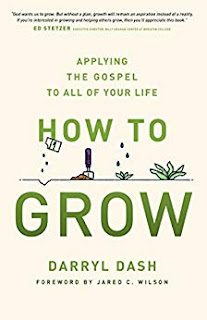I think most American pastors recognize that people showing up to church is not effective discipleship and struggle with how to effectively disciple those who attend their church. Darry Dash is a seasoned pastor who understands that struggle and had the opportunity to develop a process for discipleship from the ground up while planting a church. How to Grow: Applying the Gospel to All of Your Life is the fruit of that activity, a helpful book on the gospel and gospel growth. In this review, I will give a brief summary of each chapter and offer my observations at the end.
 The author starts out in chapter one by defining the gospel. After a lengthy summary of the bible’s storyline, he summarizes the gospel with three simple truths: God is holy, humanity is sinful, and God is rescuing both his people and his creation through the work of Jesus Christ. He then describes several implications for our lives.
The author starts out in chapter one by defining the gospel. After a lengthy summary of the bible’s storyline, he summarizes the gospel with three simple truths: God is holy, humanity is sinful, and God is rescuing both his people and his creation through the work of Jesus Christ. He then describes several implications for our lives.
In chapter two, Dash considers spiritual growth, stating that we are designed for growth with the desire to grow that comes with believing the gospel. He sees growth in a holistic sense, the gospel touching and spurring growth in every area of life. Contending that spiritual growth is neither just self-help or amassing more information, but rather a radically grace driven transformation process, the restoring of the image of God in us as we are freed from sinful habits and desires.
Chapter three addresses the often ignored role of desires or affections in spiritual growth, particularly joy. Joy is not optional or secondary. It is central to the christian life, finding our greatest delight in God. Our pursuit of joy is our pursuit of God’s glory.
Dash then looks at the stages of spiritual growth in chapter four, offering a growth pathway to spiritual maturity he has developed. It was refreshing to see that one of those stages is making disciples or mentoring others.
In chapter five, while readily acknowledging the complexity of spiritual growth, this veteran pastor challenges Christians to master three basics as the basis for spiritual growth: knowing God, worshipping God, and obeying God. He concludes the chapter by laying out the case for community being indispensable for spiritual growth.
The author expands upon the role of habits for spiritual growth in chapter six. He starts by addressing inadequate ways of pursuing growth through learning more, making bigger goals, and sheer willpower then gives a practical discussion on the role of habits in spiritual growth that puts us in the path of God’s grace. This includes how they are formed and the necessity of creating good habits for spiritual growth. This chapter is worth the price of the book.
Chapter seven builds upon the three basics described in chapter five as the core habits for spiritual growth, bible reading, prayer, and worshipping with a church community. The author gives sage advice on cultivating bible reading, prayer life, and involvement in a church community.
In chapter eight, Dash builds upon three core habits with six more supporting practices or habits. These include the Sabbath, giving generously, serving others, sharing the gospel, caring for your health, and developing a rule of life. For the unfamiliar, a rule of life is a guiding set of principles for your life to help you not only define but also live a productive, fulfilling, and God centered life. I found his discussion on giving and sharing the gospel especially full of practical wisdom. And his section on sharing the gospel centers around hospitality as a means of living on mission with the testimony of Rosaria Butterfield.
In the last chapter, the author challenges all Christians to engage in making disciples. He argues that God calls all ordinary Christians to make disciples.
The book ends with three appendixes. The first is a good list of recommended resources for growth. The second is a guide on developing a rule of life as discussed in chapter eight. The third appendix encourages pastors and church leaders to develop a culture for discipleship by being intentional about making disciples in the local church. Lastly, the author shares briefly about his ministry, Gospel for Life, as a resource for that process. If something he wrote piqued your interest, I recommend scouring the bibliography for additional reading!
As a pastor reworking our church’s own process for making disciples, How to Grow is helpful. The author gives a theological foundation, often missing in books on spiritual growth and discipleship. Yet he is also very practical. Chapter summaries highlight the key points made, questions for reflection or discussion, and then suggestions for making application. This book would be a good option for a discipleship group.
I will close with one minor concern. The author recommends that those who identify as Christians but have no active or vital relationship with God to not settle for a such a nominal faith. This seems to contradict chapter two where he argues that we are designed to grow and that faith creates desires within us. It is possible that someone in this predicament may profess faith but not really possess faith (i.e. Mat 7:21-23; James 2:14-26).
You can get the book on Amazon.

